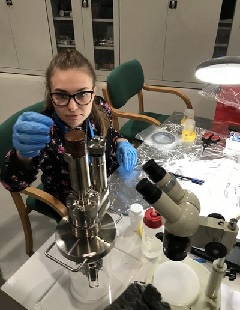
 Web Content Display
Web Content Display
SOLARIS centre
 Web Content Display
Web Content Display
 Web Content Display
Web Content Display
Titanium dioxide is the hero of the first IFJ PAN research in Solaris!

Not so many compounds are as important to industry and medicine today as titanium dioxide (TiO2). The electronic structure of transition metal oxides is an important factor determining the chemical and optical properties of materials. Specifically for metal-oxide structures, the crystal-field interaction determines the shape and occupancy of electronic orbitals. Consequently, the crystal-field splitting and resulting unoccupied state populations can be foreseen as modeling factors of the photochemical activity. The research on titanium dioxide inaugurated the presence of IFJ PAN scientists in research programs carried out at the SOLARIS synchrotron. The measurements, co-financed by the National Science Center, were carried out at the XAS beamline.
In many chemical reactions, TiO2 appears as a catalyst. As a pigment, it occurs in plastics, paints, and cosmetics, while in medical implants, it guarantees their high biocompatibility. A group of scientists from the Institute of Nuclear Physics of the Polish Academy of Sciences (IFJ PAN) in Krakow, led by Dr. Jakub Szlachetka, engaged in research on the oxidation processes of the outer layers of titanium samples and related changes in the electronic structure of this material. Scientists from the IFJ PAN conducted their latest measurements, co-financed by the National Science Center, at the XAS beamline. They analyzed how X-rays are absorbed by the surface layers of titanium samples previously produced at the Institute under carefully controlled conditions.
“We focused on the observations of changes in the electronic structure of the surface layers of samples depending on temperature changes and the progress of the oxidation process. For this purpose, we heated the titanium disks at various temperatures and in the ambient atmosphere, which, after transporting to the synchrotron, were irradiated with synchrotron radiation, i.e. X-ray radiation. Since the properties of synchrotron radiation are well known, we were able to use it to precisely determine the structure of unoccupied electronic states of titanium atoms and on this basis to conclude about changes in the structure of the material itself” says Ph.D. student Klaudia Wojtaszek (IFJ PAN), the first author of the article published in the Journal of Physical Chemistry A.
The full text of the article is available here.
